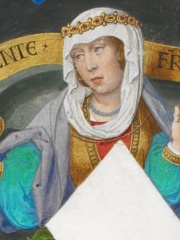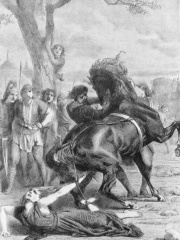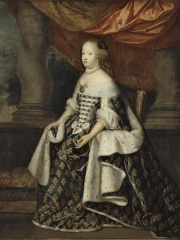
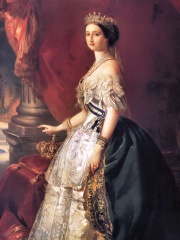
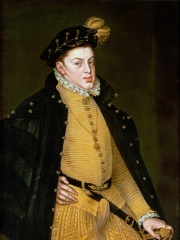
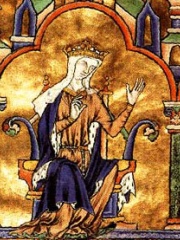
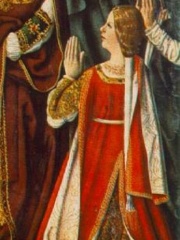
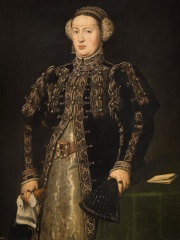
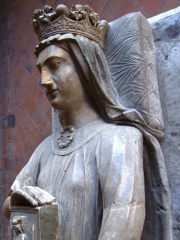
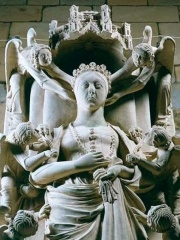
The Most Famous
COMPANIONS from Spain
This page contains a list of the greatest Spanish Companions. The pantheon dataset contains 784 Companions, 42 of which were born in Spain. This makes Spain the birth place of the 5th most number of Companions behind United Kingdom, and Italy.
Top 10
The following people are considered by Pantheon to be the top 10 most legendary Spanish Companions of all time. This list of famous Spanish Companions is sorted by HPI (Historical Popularity Index), a metric that aggregates information on a biography's online popularity. Visit the rankings page to view the entire list of Spanish Companions.

1. Maria Theresa of Spain (1638 - 1683)
With an HPI of 79.37, Maria Theresa of Spain is the most famous Spanish Companion. Her biography has been translated into 48 different languages on wikipedia.
Maria Theresa of Spain (Spanish: María Teresa de Austria; French: Marie-Thérèse d'Autriche; 10 September 1638 – 30 July 1683) was Queen of France from 1660 to 1683 as the wife of King Louis XIV. She was born an Infanta of Spain and Portugal as the daughter of King Philip IV and Elisabeth of France, and was also an Archduchess of Austria as a member of the Spanish branch of the House of Habsburg. Her marriage in 1660 to King Louis XIV, her double first cousin, was arranged with the purpose of ending the lengthy war between France and Spain. Famed for her virtue and piety, she saw five of her six children die in early childhood, and is frequently viewed as an object of pity in historical accounts of her husband's reign, since she was often neglected by the court and overshadowed by the King's many mistresses. Without any political influence in the French court or government (except briefly in 1672, when she was named regent during her husband's absence during the Franco-Dutch War, making her the last Queen of France to hold a regency), she died aged 44 due to complications from an abscess on her arm. Her grandson Philip V inherited the Spanish throne in 1700 after the death of her younger half-brother, Charles II. The resulting War of the Spanish Succession established the House of Bourbon as the new ruling dynasty of Spain, where it has reigned with some interruption until the present time.

2. Eugénie de Montijo (1826 - 1920)
With an HPI of 76.79, Eugénie de Montijo is the 2nd most famous Spanish Companion. Her biography has been translated into 48 different languages.
Eugénie de Montijo (French: [øʒeni də mɔ̃tiʁo]; born María Eugenia Ignacia Agustina de Palafox y Kirkpatrick; 5 May 1826 – 11 July 1920) was Empress of the French from her marriage to Napoleon III on 30 January 1853 until he was overthrown on 4 September 1870. From 28 July to 4 September 1870, she was the de facto head of state of France. Born to prominent Spanish nobility, Eugénie was educated in France, Spain, and England. As Empress, she used her influence to champion "authoritarian and clerical policies"; her involvement in politics earned her much criticism from contemporaries. Napoléon and Eugénie had one child together, Louis-Napoléon, Prince Imperial (1856–1879). After the fall of the Empire, the three lived in exile in England; Eugénie outlived both her husband and son and spent the remainder of her life working to commemorate their memories and the memory of the Second French Empire.

3. Carlos, Prince of Asturias (1545 - 1568)
With an HPI of 76.31, Carlos, Prince of Asturias is the 3rd most famous Spanish Companion. His biography has been translated into 41 different languages.
Don Carlos, Prince of Asturias (8 July 1545 – 24 July 1568), was the eldest son and heir apparent of King Philip II of Spain. His mother was Maria Manuela of Portugal, daughter of John III of Portugal. Carlos was known to be mentally unstable and was imprisoned by his father in early 1568, dying after half a year of solitary confinement. His imprisonment and death were utilized in Spain's Black Legend. His life inspired the play Don Carlos by Friedrich Schiller and the opera Don Carlos by Giuseppe Verdi.

4. Blanche of Castile (1188 - 1252)
With an HPI of 74.27, Blanche of Castile is the 4th most famous Spanish Companion. Her biography has been translated into 45 different languages.
Blanche of Castile (Spanish: Blanca de Castilla; French: Blanche de Castille; 4 March 1188 – 27 November 1252) was Queen of France by marriage to Louis VIII. She acted as regent twice during the reign of her son, Louis IX: during his minority from 1226 until 1234, and during his absence from 1248 until 1252.
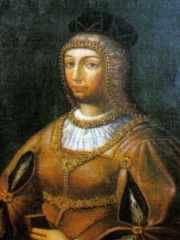
5. Maria of Aragon, Queen of Portugal (1482 - 1517)
With an HPI of 73.69, Maria of Aragon, Queen of Portugal is the 5th most famous Spanish Companion. Her biography has been translated into 39 different languages.
Maria of Aragon (29 June 1482 – 7 March 1517) was Queen of Portugal from 30 October 1500 until her death in 1517 as the second wife of King Manuel I. Manuel was the widower of Maria's elder sister, Isabella.

6. Isabella of Aragon, Queen of Portugal (1470 - 1498)
With an HPI of 73.67, Isabella of Aragon, Queen of Portugal is the 6th most famous Spanish Companion. Her biography has been translated into 42 different languages.
Isabella, Princess of Asturias (2 October 1470 – 23 August 1498), also known as Isabella of Aragon, was the eldest child and heiress presumptive of King Ferdinand II of Aragon and Queen Isabella I of Castile. She was Queen of Portugal as the wife of King Manuel I from 30 September 1497 until her death the following year.

7. Catherine of Austria, Queen of Portugal (1507 - 1578)
With an HPI of 72.27, Catherine of Austria, Queen of Portugal is the 7th most famous Spanish Companion. Her biography has been translated into 38 different languages.
Catherine of Austria or Catherine of Spain (Portuguese: Catarina; 14 January 1507 – 12 February 1578) was a Queen of Portugal as the wife of King John III, and a regent during the minority of her grandson, King Sebastian, from 1557 until 1562.

8. Berengaria of Navarre (1165 - 1230)
With an HPI of 71.53, Berengaria of Navarre is the 8th most famous Spanish Companion. Her biography has been translated into 40 different languages.
Berengaria of Navarre (Basque: Berengela, Spanish: Berenguela, French: Bérengère; c. 1165–1170 – 23 December 1230) was Queen of England as the wife of Richard I of England. She was the eldest daughter of Sancho VI of Navarre and Sancha of Castile. As is the case with many of the medieval English queens, little is known of her life. Traditionally known as "the only English queen never to set foot in the country", she may in fact have visited England after her husband's death, but did not do so before, nor did she see much of Richard during her marriage, which was childless. She did (unusually for the wife of a crusader) accompany him on the start of the Third Crusade, but mostly lived in his French possessions, where she gave generously to the church, despite difficulties in collecting the pension she was due from Richard's brother and successor John after she became a widow.

9. Inês de Castro (1325 - 1355)
With an HPI of 71.31, Inês de Castro is the 9th most famous Spanish Companion. Her biography has been translated into 31 different languages.
Inês de Castro (Portuguese pronunciation: [iˈneʒ ðɨ ˈkaʃtɾu]; in Castilian: Inés; 1325 – 7 January 1355) was a Galician noblewoman and courtier, best known as the lover and posthumously recognized wife of King Pedro I of Portugal. The dramatic circumstances of her relationship with Pedro (at the time Prince of Portugal), which was forbidden by his father Afonso IV of Portugal, her murder at the orders of Afonso, Pedro's bloody revenge on her killers, and the legend of the coronation of her exhumed corpse by Pedro, have made Inês de Castro a frequent subject of art, music, drama and poetry through the ages.
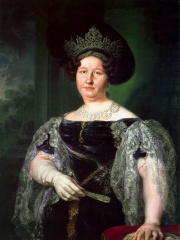
10. María Isabella of Spain (1789 - 1848)
With an HPI of 69.83, María Isabella of Spain is the 10th most famous Spanish Companion. Her biography has been translated into 30 different languages.
Maria Isabella of Spain (Spanish: María Isabel de Borbón y Borbón-Parma; 6 July 1789 – 13 September 1848) was Queen of the Two Sicilies from 4 January 1825 until 8 November 1830 as the wife of Francis I of the Two Sicilies. Maria Isabella was the youngest daughter of King Charles IV of Spain and Maria Luisa of Parma, the second daughter of Philip, Duke of Parma, and Louise-Élisabeth of France, and thus a granddaughter of King Louis XV of France. Maria Isabella's siblings included King Ferdinand VII of Spain, Carlota Joaquina, Queen of Portugal, and the Count of Molina. Maria Isabella was born into political turmoil, coinciding with the events of the French Revolution and the rise of Manuel Godoy. She received a rudimentary education and was featured in the painting Charles IV of Spain and His Family, painted by the famed Goya. Considered by her mother as a potential Empress of France, Maria Isabella instead married her cousin Prince Francis, Duke of Calabria, later King Francis I of the Two Sicilies, and had many children. The family was forced to flee to Sicily in early 1806 when after several attempted invasions by Joachim Murat, brother-in-law of Emperor Napoleon, who had already succeeded in becoming King of Naples. However, they were returned to the mainland in Naples with the intervention of the British military. In 1812, her husband was appointed regent for his elderly father and in 1825, the old king died, making Maria Isabella Queen consort of the Two Sicilies. She was known for her frivolity, and kept an active correspondence with her family in Spain, later marrying a young nobleman of the House of Baux. She died in 1848 at the age of 59; many of her children making marriages to their Spanish and Portuguese relatives.
People
Pantheon has 42 people classified as Spanish companions born between 356 and 1860. Of these 42, none of them are still alive today. The most famous deceased Spanish companions include Maria Theresa of Spain, Eugénie de Montijo, and Carlos, Prince of Asturias.
Deceased Spanish Companions
Go to all RankingsMaria Theresa of Spain
1638 - 1683
HPI: 79.37
Eugénie de Montijo
1826 - 1920
HPI: 76.79
Carlos, Prince of Asturias
1545 - 1568
HPI: 76.31
Blanche of Castile
1188 - 1252
HPI: 74.27
Maria of Aragon, Queen of Portugal
1482 - 1517
HPI: 73.69
Isabella of Aragon, Queen of Portugal
1470 - 1498
HPI: 73.67
Catherine of Austria, Queen of Portugal
1507 - 1578
HPI: 72.27
Berengaria of Navarre
1165 - 1230
HPI: 71.53
Inês de Castro
1325 - 1355
HPI: 71.31
María Isabella of Spain
1789 - 1848
HPI: 69.83
Joanna la Beltraneja
1462 - 1530
HPI: 69.53
Brunhilda of Austrasia
543 - 613
HPI: 68.90
Overlapping Lives
Which Companions were alive at the same time? This visualization shows the lifespans of the 7 most globally memorable Companions since 1700.

